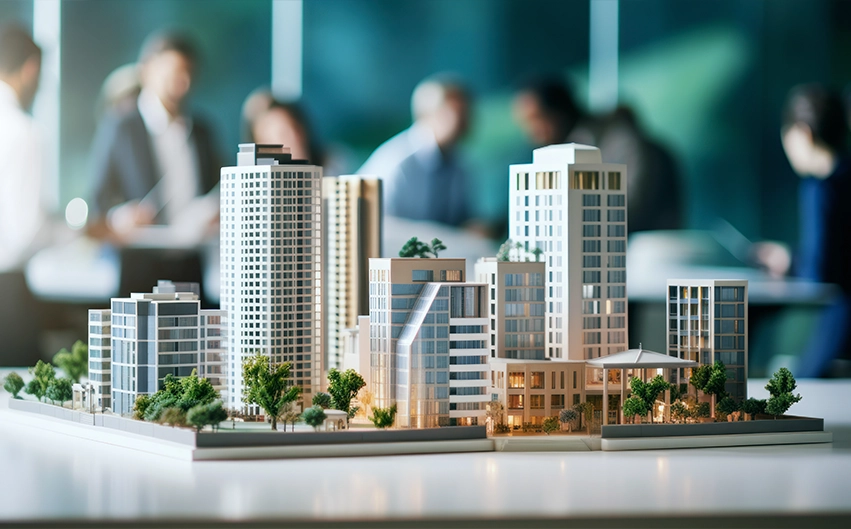When it comes to investing in the real estate world, two main sectors stand out: commercial and residential properties. But which one is the right choice for you? When you are thinking about your next investment move with Ganga Realty, understanding the differences between these two sectors is crucial. So, before you unpack your investment bags, let us help you understand the difference between Commercial Vs. Residential real estate that will help you pave your way to potential profits in the real estate world.
Table of Contents
Commercial Vs. Residential Real Estate: What’s the Difference?
Residential real estate is like a sweet home where people live, whether they own or rent the place. Think of cosy apartments, charming houses, or even swanky condos—anything that gives you that ‘homey’ vibe. On the other hand, commercial real estate is the place where business gets real. Offices, shops, warehouses—any spot where businesses do their thing. It is all about the hustle and bustle of making money, not cosying up for a snooze.
1. Commercial vs. Residential: Return on Investment
At Ganga Realty, the team is all about making real estate sound as simple as the alphabet so you can make the best investment decisions. Understand the return on investment in this case:
- Residential Benefits: Investing in homes can be like having a steady cash flow. It is because we always need a place to call home. Renting out a house or an apartment often means regular rent money landing in your pocket. It is a reliable way to keep your finances ticking.
- Commercial Benefits: Now, commercial spaces come with their own set of perks. One great thing is that leases tend to be longer in the business world. That means more stability. Plus, the rent for commercial properties is usually on the higher side compared to residential places. So, if you are looking to fill up your bank faster, this is a good place to start.
2. Commercial vs. Residential: Risk Factors
It is important to understand the risk associated with the desired investment. At Ganga Realty, we are here to give you plain and simple information so you can understand the risks that come with each option:
- Residential Risks: With homes, there might be times when the property is vacant, meaning no rent money. Also, the value of residential properties might not increase rapidly.
- Commercial Risks: Businesses can face tough times. If a business renting your space struggles, they might leave or not pay rent. Finding new tenants might take longer, causing a loss of income.
3. Commercial vs. Residential: The Impact of Location
With Ganga Realty, understanding the location’s role in the real estate story is like knowing where “X” marks the treasure spot on the map. It can lead you to the following potential profits:
- Residential Location: People often look for homes in nice neighbourhoods close to schools, parks, and good facilities. So, the location can greatly impact the value.
- Commercial Location: Businesses want places with high foot traffic, near offices or shopping areas. The location plays a big role in the success of a business, affecting the value of the property.
4. Commercial vs. Residential: Value Appreciation
Understanding the growth patterns of both assets is essential before making the big move. Let us take a closer look at how value appreciation in these sectors can help you chart your course to the pot of gold in real estate investments:
- Residential Growth: Homes often take the slow and steady road when it comes to value growth. With time, they usually become more valuable, but it might not happen quickly.
- Commercial Growth: When businesses grow, the value of commercial spaces can shoot up fast. If the area becomes popular, the property value might rise swiftly.
5. Commercial vs. Residential: Decision Time
At Ganga Realty, understanding these choices is like having a compass in the real estate jungle. It guides you to make an investment decision that fits your style and goals. Let us understand why decision-making time is a crucial aspect:
- Residential: It may suit you if you are all about stability and want a steady income flow. Homes might be your cosy spot, even if the value appreciation might be slower.
- Commercial: It might be your thing if you can handle slightly more risk but want the potential for higher returns. And if you are patient, finding the right tenant can take time.
The Final Verdict
Both sectors have their pros and cons. It is crucial to consider your goals, the money you can invest, and your comfort with risk. So, to sum up:
- Both Have Their Perks: Whether it is residential or commercial, each comes with its bag of goodies. Residential means stability, while commercial offers the potential for higher returns.
- Stability vs. Risk: Residential investments can bring you the comfort of stability. Meanwhile, commercial spaces might be a bit more like a rollercoaster with higher risks and potential gains.
- Income Streams: Homes promise a reliable income through regular rent payments. Commercial properties with higher rents can bring in more money but with the challenge of finding the right tenant.
- Value Appreciation: Residential properties usually increase in value over time, though not rapidly. On the flip side, commercial spaces can experience rapid value growth in a bustling business area.
- Location Matters: The impact of location is crucial. Residential properties benefit from good neighbourhoods, while commercial spaces thrive in high-traffic areas.
- Decision Time: If stability is your game, residential spaces might be your calling. But if you are up for a bit more risk and the potential for higher rewards, commercial properties could be your scene.
- Understanding Your Goals: It is all about what suits your investment style and future goals. Whether it is steady income or potential higher returns, understanding your preferences is crucial.
Final Thoughts
Whether you lean towards residential or commercial real estate, both have its perks and drawbacks. It is crucial to understand your preferences, your financial situation, and the level of risk you are comfortable with. And always remember that a well-informed decision is the key to successful real estate investments.
So, take your time, explore the options, and make a choice that aligns with your investment dreams.








